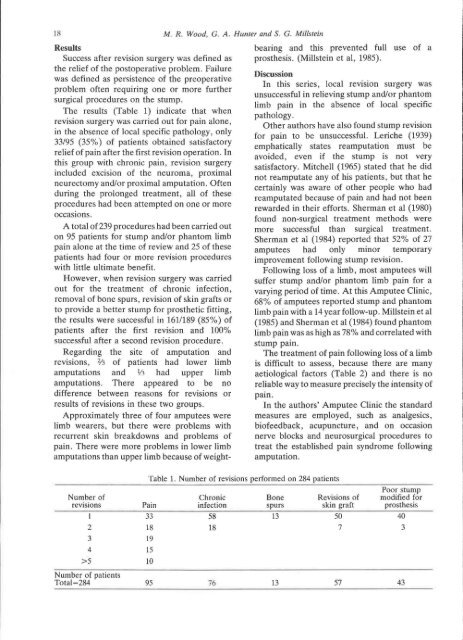View Complete Issue PDF
View Complete Issue PDF
View Complete Issue PDF
You also want an ePaper? Increase the reach of your titles
YUMPU automatically turns print PDFs into web optimized ePapers that Google loves.
Results<br />
Success after revision surgery was defined as<br />
the relief of the postoperative problem. Failure<br />
was defined as persistence of the preoperative<br />
problem often requiring one or more further<br />
surgical procedures on the stump.<br />
The results (Table 1) indicate that when<br />
revision surgery was carried out for pain alone,<br />
in the absence of local specific pathology, only<br />
33/95 (35%) of patients obtained satisfactory<br />
relief of pain after the first revision operation. In<br />
this group with chronic pain, revision surgery<br />
included excision of the neuroma, proximal<br />
neurectomy and/or proximal amputation. Often<br />
during the prolonged treatment, all of these<br />
procedures had been attempted on one or more<br />
occasions.<br />
A total of 239 procedures had been carried out<br />
on 95 patients for stump and/or phantom limb<br />
pain alone at the time of review and 25 of these<br />
patients had four or more revision procedures<br />
with little ultimate benefit.<br />
However, when revision surgery was carried<br />
out for the treatment of chronic infection,<br />
removal of bone spurs, revision of skin grafts or<br />
to provide a better stump for prosthetic fitting,<br />
the results were successful in 161/189 (85%) of<br />
patients after the first revision and 100%<br />
successful after a second revision procedure.<br />
Regarding the site of amputation and<br />
revisions, 2/3 of patients had lower limb<br />
amputations and 1/3 had upper limb<br />
amputations. There appeared to be no<br />
difference between reasons for revisions or<br />
results of revisions in these two groups.<br />
Approximately three of four amputees were<br />
limb wearers, but there were problems with<br />
recurrent skin breakdowns and problems of<br />
pain. There were more problems in lower limb<br />
amputations than upper limb because of weightbearing<br />
and this prevented full use of a<br />
prosthesis. (Millstein et al, 1985).<br />
Discussion<br />
In this series, local revision surgery was<br />
unsuccessful in relieving stump and/or phantom<br />
limb pain in the absence of local specific<br />
pathology.<br />
Other authors have also found stump revision<br />
for pain to be unsuccessful. Leriche (1939)<br />
emphatically states reamputation must be<br />
avoided, even if the stump is not very<br />
satisfactory. Mitchell (1965) stated that he did<br />
not reamputate any of his patients, but that he<br />
certainly was aware of other people who had<br />
reamputated because of pain and had not been<br />
rewarded in their efforts. Sherman et al (1980)<br />
found non-surgical treatment methods were<br />
more successful than surgical treatment.<br />
Sherman et al (1984) reported that 52% of 27<br />
amputees had only minor temporary<br />
improvement following stump revision.<br />
Following loss of a limb, most amputees will<br />
suffer stump and/or phantom limb pain for a<br />
varying period of time. At this Amputee Clinic,<br />
68% of amputees reported stump and phantom<br />
limb pain with a 14 year follow-up. Millstein et al<br />
(1985) and Sherman et al (1984) found phantom<br />
limb pain was as high as 78% and correlated with<br />
stump pain.<br />
The treatment of pain following loss of a limb<br />
is difficult to assess, because there are many<br />
aetiological factors (Table 2) and there is no<br />
reliable way to measure precisely the intensity of<br />
pain.<br />
In the authors' Amputee Clinic the standard<br />
measures are employed, such as analgesics,<br />
biofeedback, acupuncture, and on occasion<br />
nerve blocks and neurosurgical procedures to<br />
treat the established pain syndrome following<br />
amputation.<br />
Table 1. Number of revisions performed on 284 patients
















